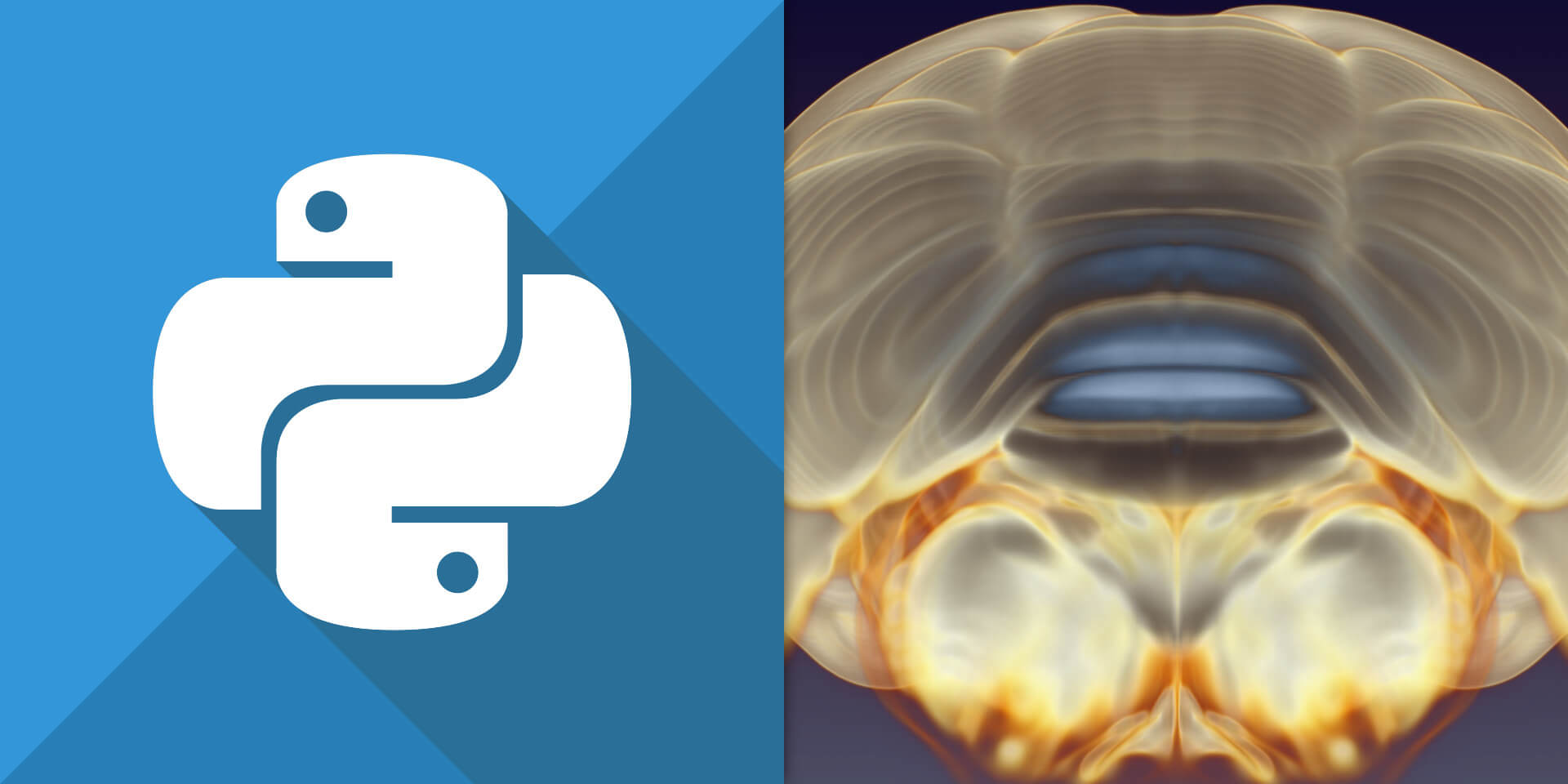介紹如何使用 Python 與 SimpleElastix 處理 3D 影像對準,並顯示處理結果。
Allen Mouse Brain Common Coordinate Framework
第三代的 Allen Mouse Brain Common Coordinate Framework(簡稱 CCFv3)提供了高解析度的老鼠腦圖譜,這裡我們使用 CCFv3 的腦影像作為基準,將自己的腦影像與 CCFv3 的腦影像進行影像對準。
CCFv3 的高解析度標準腦影像可以從 Allen Brain Altas 的網頁下載。
# USHORT(16 bit) anatomical template of CCFv3 - a shape and intensity average of 1675 specimen brains wget http://download.alleninstitute.org/informatics-archive/current-release/mouse_ccf/average_template/average_template_10.nrrd wget http://download.alleninstitute.org/informatics-archive/current-release/mouse_ccf/average_template/average_template_25.nrrd wget http://download.alleninstitute.org/informatics-archive/current-release/mouse_ccf/average_template/average_template_50.nrrd wget http://download.alleninstitute.org/informatics-archive/current-release/mouse_ccf/average_template/average_template_100.nrrd # FLOAT(32 bit) reconstructed Allen Reference Atlas Nissl deformably registered to the anatomical template of CCFv3 wget http://download.alleninstitute.org/informatics-archive/current-release/mouse_ccf/ara_nissl/ara_nissl_10.nrrd wget http://download.alleninstitute.org/informatics-archive/current-release/mouse_ccf/ara_nissl/ara_nissl_25.nrrd wget http://download.alleninstitute.org/informatics-archive/current-release/mouse_ccf/ara_nissl/ara_nissl_50.nrrd wget http://download.alleninstitute.org/informatics-archive/current-release/mouse_ccf/ara_nissl/ara_nissl_100.nrrd # UINT (32 bit) structure gray matter and fiber tract annotation of CCFv3 (May 2015) wget http://download.alleninstitute.org/informatics-archive/current-release/mouse_ccf/annotation/ccf_2015/annotation_10.nrrd wget http://download.alleninstitute.org/informatics-archive/current-release/mouse_ccf/annotation/ccf_2015/annotation_25.nrrd wget http://download.alleninstitute.org/informatics-archive/current-release/mouse_ccf/annotation/ccf_2015/annotation_50.nrrd wget http://download.alleninstitute.org/informatics-archive/current-release/mouse_ccf/annotation/ccf_2015/annotation_100.nrrd
CCFv3 所提供的影像都是 nrrd 格式,可以使用 Python 的 nrrd 模組來讀取,使用前先安裝該模組:
# 安裝 pynrrd 模組
sudo pip3 install pynrrd
讀取影像之後取出切面影像觀看:
import nrrd import matplotlib.pyplot as plt # 讀取 NRRD 影像(平均標準腦) avgImg, avgMeta = nrrd.read('average_template_25.nrrd'); # 抽取影像切面 sliceImg = avgImg[264,:,:] # 顯示 2D 影像 plt.imshow(sliceImg, cmap = 'gray') plt.show()
顯示腦區標注影像:
anoImg, anoMeta = nrrd.read('annotation_25.nrrd'); sliceImg = anoImg[264,:,:].astype(float) plt.imshow(sliceImg, vmin = 0, vmax = 1000, cmap = 'jet') plt.show()
基本影像比對
比對 fixed 與 moving 兩張影像,以旋轉方式修正影方向:
import SimpleITK as sitk import matplotlib.pyplot as plt from matplotlib.pyplot import figure import numpy as np # 讀取 CCFv3 標準腦與自己的腦影像 fixedITKImage = sitk.ReadImage("average_template_25.nrrd") movingITKImage = sitk.ReadImage("my_image.nrrd") # 轉為 NumPy 陣列 fixedImage = sitk.GetArrayViewFromImage(fixedITKImage) movingImage = sitk.GetArrayViewFromImage(movingITKImage) # 旋轉影像 movingImageRotation = np.rot90(movingImage, 1, (1, 2)) movingImageRotation = np.rot90(movingImageRotation, 2, (0, 1)) print("Fixed Image: {}".format(fixedImage.shape)) print("Moving Image(Rotation): {}".format(movingImageRotation.shape)) # 顯示各方向影像切面 fig, axs = plt.subplots(2, 3, figsize=(15, 10)) axs[0,0].imshow(fixedImage[fixedImage.shape[0]//2,:,:], cmap = 'jet') axs[0,0].set_title('fixedImage(X)') axs[0,1].imshow(fixedImage[:,fixedImage.shape[1]//2,:], cmap = 'jet') axs[0,1].set_title('fixedImage(Y)') axs[0,2].imshow(fixedImage[:,:,fixedImage.shape[2]//2], cmap = 'jet') axs[0,2].set_title('fixedImage(Z)') windowSize = 300 sliceX = movingImageRotation[movingImageRotation.shape[0]//2,:,:] axs[1,0].imshow(sliceX, vmin = sliceX.min(), vmax = sliceX.min() + windowSize, cmap = 'jet') axs[1,0].set_title('movingImage(X)') sliceY = movingImageRotation[:,movingImageRotation.shape[1]//2,:] axs[1,1].imshow(sliceY, vmin = sliceY.min(), vmax = sliceY.min() + windowSize, cmap = 'jet') axs[1,1].set_title('movingImage(Y)') sliceZ = movingImageRotation[:,:,movingImageRotation.shape[2]//2] axs[1,2].imshow(sliceZ, vmin = sliceZ.min(), vmax = sliceZ.min() + windowSize, cmap = 'jet') axs[1,2].set_title('movingImage(Z)') plt.show() # 輸出影像 image = sitk.GetImageFromArray(movingImageRotation) vs = movingITKImage.GetSpacing() image.SetSpacing([vs[0], vs[2], vs[1]]) sitk.WriteImage(image, "my_image_rotation.nrrd")
增加 Fixed 影像邊緣
增加 Fixed 影像邊緣大小:
import SimpleITK as sitk import matplotlib.pyplot as plt # 讀取 CCFv3 標準腦影像 fixedITKImage = sitk.ReadImage("average_template_25.nrrd") # 取得原始影像大小 fixedImageSize = fixedITKImage.GetSize() # 增添空白框邊 padding = 100 # 建立空白影像 expand = sitk.Image(fixedImageSize[0] + padding * 2, fixedImageSize[1] + padding * 2, fixedImageSize[2] + padding * 2, sitk.sitkUInt16) # 貼上原始影像 result = sitk.Paste(expand, fixedITKImage, fixedImageSize, (0, 0, 0), (padding, padding, padding)) # 轉為 NumPy 陣列 nda = sitk.GetArrayViewFromImage(result) # 顯示影像切面 plt.imshow(nda[nda.shape[0]//2,:,:]) plt.show() # 設定 Voxel Size result.SetSpacing(fixedITKImage.GetSpacing()) # 輸出影像 sitk.WriteImage(result, "average_template_25_expand.nrrd")
影像對準
使用 SimpleElastix 進行影像對準:
import SimpleITK as sitk import matplotlib.pyplot as plt from matplotlib.pyplot import figure import numpy as np # 讀取 CCFv3 標準腦與自己的腦影像 fixedITKImage = sitk.ReadImage("average_template_25_expand.nrrd") movingITKImage = sitk.ReadImage("my_image_rotation.nrrd") # 影像資訊 print("Fixed Image:") print(" Image Size: {}".format(fixedITKImage.GetSize())) print(" Voxel Size: {}".format(fixedITKImage.GetSpacing())) print("Moving Image:") print(" Image Size: {}".format(movingITKImage.GetSize())) print(" Voxel Size: {}".format(movingITKImage.GetSpacing())) # 影像對準 elastixImageFilter = sitk.ElastixImageFilter() elastixImageFilter.SetFixedImage(fixedITKImage) elastixImageFilter.SetMovingImage(movingITKImage) elastixImageFilter.LogToConsoleOn() # 參數組合 #parameterMap = sitk.GetDefaultParameterMap('translation') parameterMap = sitk.ReadParameterFile("Parameters_Rigid.txt") elastixImageFilter.SetParameterMap(parameterMap) # 參數組合 #parameterMap = sitk.GetDefaultParameterMap('affine') parameterMap = sitk.ReadParameterFile("Parameters_Affine.txt") elastixImageFilter.AddParameterMap(parameterMap) # 參數組合 #parameterMap = sitk.GetDefaultParameterMap('bspline') parameterMap = sitk.ReadParameterFile("Parameters_BSpline.txt") elastixImageFilter.AddParameterMap(parameterMap) # 執行影像對準 elastixImageFilter.Execute() # 取得影像對準結果 resultITKImage = elastixImageFilter.GetResultImage() # 轉為 NumPy 陣列 fixedImage = sitk.GetArrayViewFromImage(fixedITKImage) resultImage = sitk.GetArrayViewFromImage(resultITKImage) fig, axs = plt.subplots(2, 3, figsize=(15, 10)) axs[0,0].imshow(fixedImage[fixedImage.shape[0]//2,:,:], cmap = 'jet') axs[0,0].set_title('fixedImage(X)') axs[0,1].imshow(fixedImage[:,fixedImage.shape[1]//2,:], cmap = 'jet') axs[0,1].set_title('fixedImage(Y)') axs[0,2].imshow(fixedImage[:,:,fixedImage.shape[2]//2], cmap = 'jet') axs[0,2].set_title('fixedImage(Y)') windowSize = 300 sliceX = resultImage[resultImage.shape[0]//2,:,:] axs[1,0].imshow(sliceX, vmin = sliceX.min(), vmax = sliceX.min() + windowSize, cmap = 'jet') axs[1,0].set_title('resultImage(X)') sliceY = resultImage[:,resultImage.shape[1]//2,:] axs[1,1].imshow(sliceY, vmin = sliceY.min(), vmax = sliceY.min() + windowSize, cmap = 'jet') axs[1,1].set_title('resultImage(Y)') sliceZ = resultImage[:,:,resultImage.shape[2]//2] axs[1,2].imshow(sliceZ, vmin = sliceZ.min(), vmax = sliceZ.min() + windowSize, cmap = 'jet') axs[1,2].set_title('resultImage(Z)') plt.show() # 將像素值型態轉為 UInt8 fixedImageUint8 = sitk.Cast(sitk.IntensityWindowing(fixedITKImage, windowMinimum = 0, windowMaximum = 258, outputMinimum = 0.0, outputMaximum = 255.0), sitk.sitkUInt8) resultImageUint8 = sitk.Cast(sitk.IntensityWindowing(resultITKImage, windowMinimum = 80, windowMaximum = 300, outputMinimum = 0.0, outputMaximum = 255.0), sitk.sitkUInt8) # 合併影像 rgbITKImage = sitk.Cast(sitk.Compose(resultImageUint8, fixedImageUint8, resultImageUint8), sitk.sitkVectorUInt8) rgbImage = sitk.GetArrayViewFromImage(rgbITKImage) # 顯示 RGB 影像 fig, axs = plt.subplots(3, 1, figsize=(16, 48)) sliceX = rgbImage[rgbImage.shape[0]//2,:,:] axs[0].imshow(sliceX) axs[0].set_title('resultImage(X)') sliceY = rgbImage[:,rgbImage.shape[1]//2,:] axs[1].imshow(sliceY) axs[1].set_title('resultImage(Y)') sliceZ = rgbImage[:,:,rgbImage.shape[2]//2] axs[2].imshow(sliceZ) axs[2].set_title('resultImage(Z)') plt.show() # 設定影像參數 rgbITKImage.SetOrigin(fixedITKImage.GetOrigin()) rgbITKImage.SetSpacing(fixedITKImage.GetSpacing()) # 儲存檔案 sitk.WriteImage(rgbITKImage, "result_rgb.mha")
將 fixed 與 moving 兩張影像合併為一張 RGBA 彩色影像:
# 建立透明度 alpha = sitk.MaximumImageFilter().Execute(fixedImageUint8, resultImageUint8) # 合併為 RGBA 影像 rgbaITKImage = sitk.Cast(sitk.Compose(resultImageUint8, fixedImageUint8, resultImageUint8, alpha), sitk.sitkVectorUInt8) # 設定影像參數 rgbaITKImage.SetOrigin(fixedITKImage.GetOrigin()) rgbaITKImage.SetSpacing(fixedITKImage.GetSpacing()) # 儲存檔案 sitk.WriteImage(rgbaITKImage, "result_rgba.mha")
參考資料:Allen Institute、Office 指南、Office 指南、Office 指南、SimpleITK Notebooks

